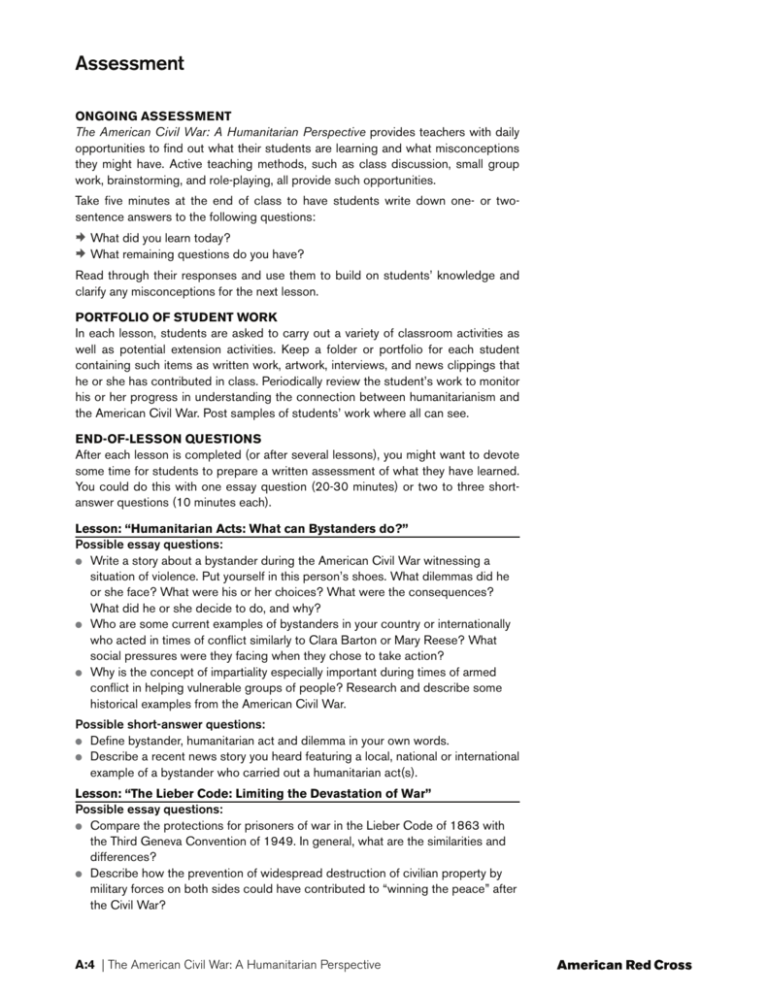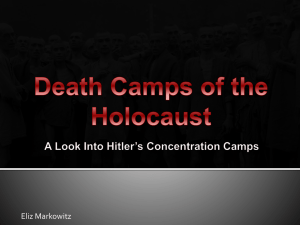Assessment - American Red Cross
advertisement

Assessment ONGOING ASSESSMENT The American Civil War: A Humanitarian Perspective provides teachers with daily OPPORTUNITIESTOlNDOUTWHATTHEIRSTUDENTSARELEARNINGANDWHATMISCONCEPTIONS they might have. Active teaching methods, such as class discussion, small group work, brainstorming, and role-playing, all provide such opportunities. 4AKE lVE MINUTES AT THE END OF CLASS TO HAVE STUDENTS WRITE DOWN ONE OR TWO sentence answers to the following questions: F 7HATDIDYOULEARNTODAY F 7HATREMAININGQUESTIONSDOYOUHAVE Read through their responses and use them to build on students’ knowledge and clarify any misconceptions for the next lesson. PORTFOLIO OF STUDENT WORK In each lesson, students are asked to carry out a variety of classroom activities as well as potential extension activities. Keep a folder or portfolio for each student containing such items as written work, artwork, interviews, and news clippings that he or she has contributed in class. Periodically review the student’s work to monitor his or her progress in understanding the connection between humanitarianism and the American Civil War. Post samples of students’ work where all can see. END-OF-LESSON QUESTIONS After each lesson is completed (or after several lessons), you might want to devote some time for students to prepare a written assessment of what they have learned. 9OUCOULDDOTHISWITHONEESSAYQUESTIONMINUTESORTWOTOTHREESHORT answer questions (10 minutes each). Lesson: “Humanitarian Acts: What can Bystanders do?” Possible essay questions: L Write a story about a bystander during the American Civil War witnessing a situation of violence. Put yourself in this person’s shoes. What dilemmas did he ORSHEFACE7HATWEREHISORHERCHOICES7HATWERETHECONSEQUENCES 7HATDIDHEORSHEDECIDETODOANDWHY L Who are some current examples of bystanders in your country or internationally WHOACTEDINTIMESOFCONmICTSIMILARLYTO#LARA"ARTONOR-ARY2EESE7HAT SOCIALPRESSURESWERETHEYFACINGWHENTHEYCHOSETOTAKEACTION L Why is the concept of impartiality especially important during times of armed CONmICTINHELPINGVULNERABLEGROUPSOFPEOPLE2ESEARCHANDDESCRIBESOME historical examples from the American Civil War. Possible short-answer questions: L $ElNEBYSTANDERHUMANITARIANACTANDDILEMMAINYOUROWNWORDS L Describe a recent news story you heard featuring a local, national or international example of a bystander who carried out a humanitarian act(s). Lesson: “The Lieber Code: Limiting the Devastation of War” Possible essay questions: L Compare the protections for prisoners of war in the Lieber Code of 1863 with the Third Geneva Convention of 1949. In general, what are the similarities and DIFFERENCES L Describe how the prevention of widespread destruction of civilian property by military forces on both sides could have contributed to “winning the peace” after THE#IVIL7AR A:4 | The American Civil War: A Humanitarian Perspective Possible short-answer questions: L 7HATDOESTHETERMhDISTINCTIONvMEANINTHE,IEBER#ODE L )NTHE,IEBER#ODEOFWHATSPECIlCGROUPSOFPEOPLEMUSTBEPROTECTED ANDTREATEDHUMANELY L (OWISTHETERMhMILITARYNECESSITYvDElNEDINTHE,IEBER#ODE L Under the Lieber Code, what categories of people and objects must receive ADDITIONALPROTECTION Lesson: “Planning a Camp for Civil War Prisoners” Possible essay questions: L Describe the challenges that faced Confederate and Union forces who cared for prisoners of war on both sides. L What are the most important services to take into account when organizing a CAMPFORPRISONERSOFWAR$ESCRIBETHERESOURCESNEEDED L What were the immediate and long-term consequences that resulted from the INHUMANETREATMENTOFPRISONERSDURINGTHE#IVIL7AR(OWMIGHTTHISTREATMENT HAVEAFFECTEDEFFORTSATRECONCILIATIONFOLLOWINGTHEENDOFTHE#IVIL7AR L How could the independent inspection of prison camp conditions by a neutral ANDIMPARTIALORGANIZATIONHELPTOIMPROVETHETREATMENTOFPRISONERS L What lessons from the Civil War can be applied to armed conflicts today in PROTECTINGLIFEANDHUMANDIGNITY L Write a story featuring yourself as a prison guard at either Andersonville or Elmira Prison during the Civil War. What challenges did you face in guarding and caring FORTHEPRISONERS Possible short-answer questions: L Describe some of the basic needs of soldiers detained as a result of armed conflict. L )NAPRISONCAMPWHATSPECIlCGROUPSAREMOREVULNERABLETHANOTHERS L As a camp planner, what are some things that should be considered when SELECTINGASITEFORACAMPFORPRISONERSOFWAR L Give several practical examples of how the lives of thousands of prisoners of war could have been spared in Civil War prison camps through improved conditions of detention. 9OUCOULDASKSTUDENTSTOFORMULATEOTHERQUESTIONSINSMALLGROUPSANDTHENSELECT ONE OF THEM AS THE ESSAY QUESTION FOR THE WHOLE CLASS 9OU COULD ALSO ASK EACH student to propose a question and then answer it. The student would be assessed on the quality of the question as well as on the answer. Another option would be to select a quote from a newspaper article, a sidebar in the materials or another source and ask students to identify the main point being made in the quote and whether they agree or disagree with it. CRITERIA FOR ASSESSMENT: !NEFFECTIVESTUDENTRESPONSEISONETHAT L uses concepts, such as bystander, humanitarian act, social pressure, impartiality, and other terms and concepts, from the lessons; L gives concrete examples to back up points; L includes examples from a variety of sources, such as the news media, interviews, class discussions, and outside reading. The above techniques are simply suggestions to help you assess your students’ work, focusing on the lesson plans from these educational resources. Feel free to adapt them to your needs. www.redcross.org/ehl The American Civil War: A Humanitarian Perspective | A:5





